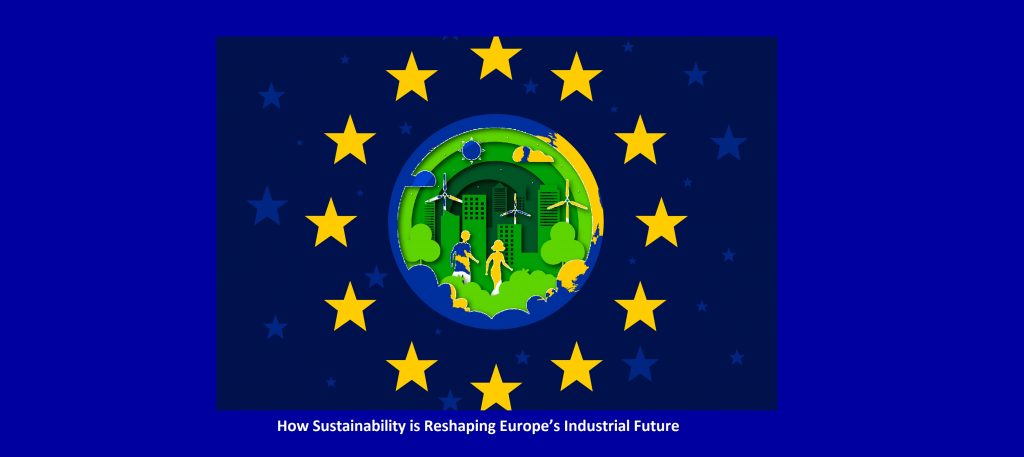How Sustainability is Reshaping Europe’s Industrial Future
Green manufacturing is transforming industries across Europe as the European Union (EU) prioritizes sustainability, carbon neutrality, and clean energy. With policies like the European Green Deal and Fit for 55, businesses are rethinking production processes to meet ambitious climate goals. However, the shift comes with both opportunities and challenges. This article explores the current landscape, key trends, and what the future holds for green manufacturing in the EU.
What is Green Manufacturing?
Green manufacturing refers to the use of environmentally friendly processes, materials, and energy sources to reduce carbon footprints while maintaining production efficiency. Companies are focusing on:
- Renewable energy adoption (solar, wind, and hydrogen).
- Waste reduction and circular economy models.
- Eco-friendly raw materials and biodegradable packaging.
- Energy-efficient production technologies.
The EU aims to become the world’s first climate-neutral continent by 2050, and manufacturing plays a crucial role in achieving this target.
Opportunities in Green Manufacturing
1. EU Funding and Incentives
The EU is heavily investing in sustainable industries.
- €1 trillion is allocated under the European Green Deal Investment Plan.
- The Innovation Fund provides financial support for companies transitioning to clean technologies.
- The EU Taxonomy Regulation encourages sustainable investments by defining “green” economic activities.
2. Competitive Advantage and Market Demand
Consumers are prioritizing sustainable products, pushing companies to innovate. According to a 2023 survey by the European Commission, 72% of EU consumers are willing to pay more for eco-friendly products. Brands that lead in sustainability gain a competitive edge.
Example: IKEA has committed to becoming 100% circular by 2030, using only renewable and recycled materials.
3. Energy Cost Savings
Switching to renewable energy and energy-efficient processes reduces long-term costs.
- Siemens reports that its energy-efficient manufacturing solutions cut electricity costs by up to 30%.
- The use of solar and wind energy has helped companies like Volkswagen lower production costs while reducing emissions.
4. Job Creation and Economic Growth
The green transition is fueling job creation across Europe.
- The EU estimates 1 million new jobs in the renewable energy sector by 2030.
- Germany alone has added 300,000 green energy jobs in the past decade.
Opportunities in Green Manufacturing
1. EU Funding and Incentives
The EU is heavily investing in sustainable industries.
- €1 trillion is allocated under the European Green Deal Investment Plan.
- The Innovation Fund provides financial support for companies transitioning to clean technologies.
- The EU Taxonomy Regulation encourages sustainable investments by defining “green” economic activities.
2. Competitive Advantage and Market Demand
Consumers are prioritizing sustainable products, pushing companies to innovate. According to a 2023 survey by the European Commission, 72% of EU consumers are willing to pay more for eco-friendly products. Brands that lead in sustainability gain a competitive edge.
Example: IKEA has committed to becoming 100% circular by 2030, using only renewable and recycled materials.
3. Energy Cost Savings
Switching to renewable energy and energy-efficient processes reduces long-term costs.
- Siemens reports that its energy-efficient manufacturing solutions cut electricity costs by up to 30%.
- The use of solar and wind energy has helped companies like Volkswagen lower production costs while reducing emissions.
4. Job Creation and Economic Growth
The green transition is fueling job creation across Europe.
- The EU estimates 1 million new jobs in the renewable energy sector by 2030.
- Germany alone has added 300,000 green energy jobs in the past decade.
Challenges in Green Manufacturing
1. High Initial Investment Costs
The transition to green manufacturing requires significant investment in new technologies, infrastructure, and training.
- A McKinsey report estimates that European manufacturers must invest €400 billion in decarbonization efforts by 2030.
- Small and medium-sized enterprises (SMEs) struggle to afford the upfront costs despite long-term benefits.
2. Supply Chain Complexities
Sourcing sustainable raw materials and components is challenging.
- The demand for rare earth metals (used in EV batteries and solar panels) is rising, leading to supply chain vulnerabilities.
- Companies need better recycling systems to reduce dependency on new raw materials.
3. Regulatory Compliance and Bureaucracy
Adapting to new EU regulations requires time and resources.
- The Carbon Border Adjustment Mechanism (CBAM) imposes carbon tariffs on imports, increasing costs for manufacturers dependent on non-EU suppliers.
- Navigating compliance with ESG (Environmental, Social, and Governance) reporting adds complexity, especially for SMEs.
4. Technological Gaps
Not all manufacturers have access to advanced green technologies.
- Many factories still rely on fossil fuels, and transitioning to green alternatives takes time.
- Investment in R&D is crucial for developing cost-effective solutions.
Future Outlook: A Sustainable Industrial Revolution?
Despite challenges, green manufacturing in the EU is accelerating. The shift toward net-zero industries, AI-driven efficiency, and circular economy models will define the future. Governments, businesses, and consumers must work together to overcome barriers and make sustainability the new standard.
Green manufacturing is a transformative movement that presents both exciting opportunities and complex challenges. As businesses invest in renewable energy, eco-friendly materials, and innovative production methods, they are not only aligning with EU climate policies but also securing their long-term success in a rapidly evolving global economy. The transition may not be easy, but for those who adapt, the future is green.
#GreenManufacturing #Sustainability #EU #CleanEnergy #CircularEconomy #RenewableEnergy #BusinessGrowth


